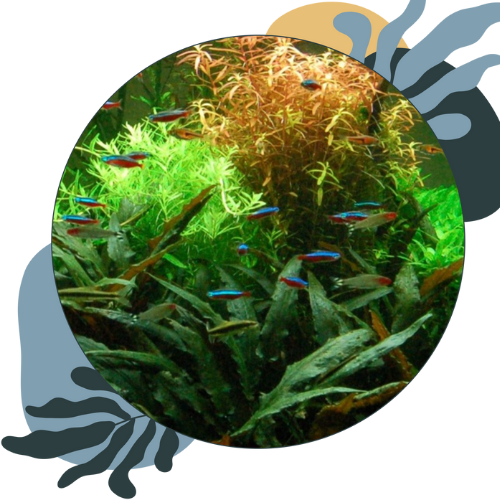One of your fish’s Five Welfare Needs is a suitable environment and it is often said that fishkeeping is not so much about looking after your fish but looking after their water. To keep our fish happy and healthy, we need to know what the water in our aquarium should and should not contain to avoid problems. We can do this by testing the water quality in our aquariums which is quick and easy to do with test kits. This leaflet aims to help you understand more about water quality: by maintaining a stable environment for our fish, it prevents any sudden changes which may be harmful to them, helping your fish and your new hobby to thrive.

Just like us, fish must go to the toilet but unlike us, they can’t then flush a toilet for their waste to be dealt with by a sewage works. We therefore need to remove this waste to prevent their water becoming polluted and affecting their health. In the aquarium (and ponds), filters fulfil the function of a sewage works (known as biofiltration). To check that this process is working properly in your aquarium, you will need to use water quality test kits. Bear in mind that your OATA retailer can provide guidance on how to do such tests at home.
It’s a common mistake that if the water looks clear, then the water quality must be fine. Much of the pollution that a fish may experience is invisible to our eyes. For example, strong acids, bleach and white spirit are all clear liquids but are highly dangerous to us!
What causes problems?
Chlorine/Chloramine
Water companies must by law provide water which is suitable for drinking. They do this by adding chlorine or chloramine to our tap water. However, these chemicals are harmful to both fish and the beneficial bacteria in your filter. Water conditioners will convert these chemicals to a non-toxic form. Media in your filter should be washed gently in water which has been removed from the aquarium during routine water changes, rather than using tap water, to prevent harming these beneficial bacteria.
Ammonia and Nitrite
In your aquarium, ammonia is excreted as waste by your fish and from the breakdown of uneaten food. Ammonia is toxic to fish, but in a mature, healthy aquarium, it is converted almost instantly by beneficial bacteria in the filter, first to nitrite (which is also toxic to fish) and then to nitrate (which is relatively non-toxic). This is known as nitrification and is part of a process called the nitrogen cycle. However, in a newly set-up or over-stocked aquaria, there will not be enough of these bacteria to enable this process.
These bacteria, known collectively as Ammonia Oxidising Bacteria (AOB) and Nitrite oxidising bacteria (NOB), will grow on any available surface in your aquarium, but as they require oxygen, they will be found particularly in your aquarium’s filter where there is greater movement and oxygenation of water.
In a newly set-up aquarium, ammonia and nitrite levels will initially rise but as the levels of beneficial bacteria increase, these levels will then fall to (and should stay at) zero. Levels of beneficial bacteria can be supplemented via proprietary products, as per the manufacturer’s instructions.
Nitrate
Nitrate is the end-product of the breakdown of ammonia, so a rising nitrate level is associated with a mature aquarium filter. Nitrate is then either taken up by plants or algae or by bacterial denitrification (completing the cycle) or is removed during partial water changes (up to 25% of your aquarium’s water should be changed every week). Frequency and size of water changes may vary according to what species you keep, the aquarium size, the number of fish you have and other factors. If in doubt, seek advice from your OATA retailer. Proprietary products are also available which can maintain or lower nitrate levels.
Testing your aquarium water
Routine testing of water quality in your aquarium is quick and easy to do and can highlight any changes before they cause problems for your fish. You should regularly monitor your water quality, ideally at least once a week to make sure parameters are at suitable levels for your fish. You should also test the water if you notice your fish behaving unusually. When the aquarium is first set up you may wish to test the water more frequently. If you’re unsure of when you should test your aquarium water, do ask your OATA retailer who will be happy to provide guidance.
Test kits are available which will each separately test the levels of pH, ammonia, nitrite, nitrate, phosphates and water hardness. When testing water, take it from the main body of the aquarium, rather than the filters. Test kits are available as either liquids, tablets or strips. All work on the same principle in that they will change colour and you then compare this to a colour chart to obtain the result.
Ammonia and nitrite levels should always be zero. Check OATA’s species specific care sheets to find out what nitrate level you should maintain your aquarium at for the species you are keeping.
What else do you need to test for?
pH
This simply refers to how acidic or alkaline a substance is and is measured on a scale from 1 to 14. As pH 7 is halfway on the scale, it is said to be neutral i.e. it is neither acidic nor alkaline. Substances with a pH value less than 7 are acidic and those with a pH value higher than 7 are alkaline. It is important to know that each whole unit change on the scale represents a factor of ten e.g. pH 4 is 10 times more acidic than pH 5 and 100 times more acidic than pH 6! If pH values change too suddenly, this could make the water too acidic or too alkaline for your fish. At high pH levels, ammonia will become more toxic.
How hard or soft is your tap water?
Most water companies now have an online water quality postcode checker which will tell you whether your tap water is hard or soft. When choosing your fish, remember that each fish species will be adapted to live in water of a particular hardness or softness, which may differ to that of your tap water. Your OATA retailer can provide guidance on what to do if your tap water is too hard or soft.
Dissolved Oxygen
Oxygen is important not only for your fish but also the beneficial bacteria that convert ammonia and nitrite. Oxygen levels should be maintained as high as possible by aeration e.g. bubbles, waterfalls, having a large surface area. Minimum levels should be 6 mg per litre.
What to do if there is a problem?
If your water test kits indicate a problem e.g. ammonia or nitrite levels are too high, these can be reduced by carrying out partial water changes and maintaining good husbandry e.g. not over-stocking, over-feeding etc. Proprietary products are available which can raise, lower or maintain pH, or to harden or soften water. Your OATA retailer can provide further help and guidance as necessary.
What to watch out for
All fish will have slight variations in their behaviour or appearance, but keeping an eye on any changes in the following will help to identify any potential problems before they become a real health issue:
- swimming behaviour – hanging at the surface, sitting on the bottom or erratic swimming
- colour – turning a darker or paler colour than normal
- temperament – changes in level of aggression or hiding more than normal
- breathing – gill covers moving at a slower or faster rate than normal
- appearance – development of white spots or fluffy growths, loss of fins or scales
- condition – increase or decrease in body weight and condition
- feeding – reduced intake or lack of interest in food
If you are concerned about the health of any of your livestock, then test your water quality and contact your OATA retailer for further guidance.
Five Welfare Needs Checklist:
The Animal Welfare Act 2006 states that all pet owners have a legal duty of care to their pets. Anyone who is cruel to an animal or is found not to be providing the five animal welfare needs, as listed below, can be prosecuted.
- A suitable environment e.g. appropriately sized tank (with water heater if tropical set up) within a suitable location in your home.
- A suitable diet which meets the needs of your chosen fish.
- Behaviour – Fish are able to exhibit their normal behaviour e.g. hiding places for timid fish, enough room for fish to swim freely.
- Companionship – Ensure you know whether your chosen fish need to be kept with, or apart from, other fish.
- Health – Protected from pain, injury, suffering & disease e.g. you are aware of the daily, weekly and monthly maintenance that your aquarium will need.
Remember...
Water quality test kits are a necessity not an optional extra.
You must be prepared to look after your fish properly for the duration of their life and provide an aquarium which can accommodate your fish when fully grown.
Never release your aquarium animals or plants into the wild. It is illegal and for most fish species this will lead to an untimely and possibly lingering death. Any animals or plants that do survive might be harmful to our native countryside. Take care to properly dispose of any soiled substrate (e.g. sand or gravel) water or decorations so that non-native organisms do not enter natural watercourses.











